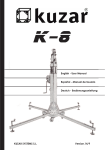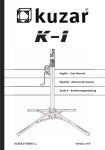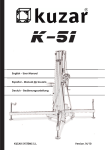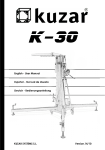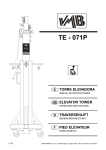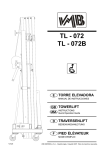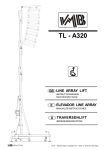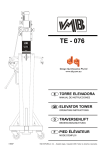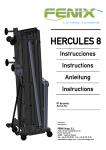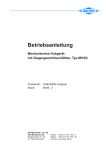Download Manual KUZAR K-3 (Versión.09.14)
Transcript
English - User Manual Español - Manual de Usuario Deutch - Bedienungsanleitung KUZAR SYSTEMS S.L. Version.14/9 125 kg (275.6lb) 5.35 m (17.6’) KUZAR SYSTEMS S.L. C/ Ciudad de Ferrol Nº8 Pol.Ind. Fuente del Jarro 46988 Paterna - Valencia (Spain) Made in Spain (EU) Manual de usuario propiedad de KUZAR SYSTEMS S.L. Deposito legal y copyright 2014. Todos los derechos reservados. K-3 2 A 1307 Tramo 4 / Section 4 1308 Tramo 3 / Section 3 1309 Tramo 2 / Section 2 4001 Cabrestante / Winch 1310 Tramo 1 Base / Section 1 2119 Nivel de Burbuja / Spirit level B C 1203 2112 Pata / Leg Tapón pata/ Leg cap 3 A Tornillo / Screw 2110 1006 Contera / Bracket A.1 A.1 1012 Tornillo / Screw A.1 2182 Gatillo / Lock Despiece / Breakdown A.1 1007 8002 1102 2002 1008 8003 7002 1007 8002 1007 8002 1103 4 B 7010 Tuerca / Nut 5002 Tornillo / Screw 1014 B.2 - Reenvío inferior Tramo 2 (Ref.1309) / Lower pulleys set Section 2 2004 1101 1005 3002 1004 1005 1010 B.3 - Reenvío inferior Tramo 3 (Ref.1308) / Lower pulleys set Section 3 1101 2001 1005 3001 1004 1005 1010 5 C Estabilizador completo / Complete stabilizer kit 2114 2115 7004 7003 8002 1011 2116 8003 1006 2113 2117 8005 1012 D 9003 Cable acero / Steel cable Cable acero / Steel cable 9003 D.1 2111 1003 8001 7001 4001 Prisionero cable / Cable clamp Tornillo / Screw Arandela / Washer Tuerca / Nut Cabrestante / Winch Despiece / Breakdown D.1 2003 7002 8004 1009 8003 6 LISTA DE REPUESTOS / SPARE PARTS LIST Code / Código Description / Descripción 1003 Allen screw M8x16 / Tornillo allen M8x16 1004 Conic screw M5x12 / Tornillo cónico M5x12 1005 Conic screw M6x16 / Tornillo cónico M6x16 1006 Allen screw M10x25/ Tornillo allen M10x25 1007 Allen screw M6x20 / Tornillo allen M6x20 1008 Special M10 screw / Tornillo especial M10 1009 Hexagonal screw M10x40 / Tornillo hexagonal M10x40 1010 Conic screw M4x35 / Tornillo cónico M4x35 1011 Allen screw M5x25 / Tornillo allen M5x25 1012 Allen screw M6x10 / Tornillo allen M6x10 1014 Hexagonal taptite screw / Tornillo taptite hexagonal 1101 Ø10 axel plate / Pletina eje Ø10 1102 Pletina portapolea / Pulley support plate 1103 K-3 threaded pulley cover plate / Pletina roscada portapoleas K-3 1203 Leg profile / Perfil pata 1307 Section 4 K-3 / Tramo 4 K-3 1308 Section 3 K-3 / Tramo 3 K-3 1309 Section 2 K-3/ Tramo 2 K-3 1310 Section 1 (Base) K-3 / Tramo 1 (Base) K-3 2001 Ø 50 Pulley / Polea Ø 50 2002 Ø 40 Pulley for upper pulley system / Polea Ø40 porta-poleas superior 2003 Ø 40 Cable entry pulley / Polea entrada cable Ø 40 2004 Ø 60 pulley / Polea Ø 60 2110 Bracket / Contrera 2111 Ø4 Cable clamp / Prisionero cable Ø4 2112 K-3 leg tap / Tapón pata K-3 2113 M14 threaded stabilizer / Esparrago M14 estabilizador 2114 Complete stabilizer / Estabilizador completo 2115 Stabilizer ball / Bola del estabilizador 2116 Stabilizer handle / Manivela estabilizador 2117 Stabilizer plate Ø 80 / Plato estabilizador Ø 80 2119 Spirit level indicator / Nivel de burbuja 7 LISTA DE REPUESTOS / SPARE PARTS LIST Code / Código Description / Descripción 2182 KAT Lock K-3 / Gatillo KAT K-3 3001 Ø10 x 50 Axel / Eje Ø10 x 50 3002 Ø10 x 60 Axel / Eje Ø10 x 60 4001 450 Kg Winch / Cabrestante 450 kg 5002 Wheel Ø 80 K-3 / Rueda Ø 80 K-3 7001 Auto-block nut M8 / Tuerca autoblocante M8 7002 Auto-block nut M8 / Tuerca autoblocante M8 7003 Nut M10 / Tuerca M10 7004 Auto-block nut M5 / Tuerca autoblocante M5 7005 Nut M6 / Tuerca M6 7010 M6 Auto-block nut / Tuerca autoblocante M6 8001 Flat M8 washer / Arandela plana M8 8002 M6 washer / Arandela M6 8003 Flat M10 washer / Arandela plana M10 8004 M12 washer / Arandela M12 8005 Wide M6 washer / Arandela M6 ancha 9003 K-3 Cable (Ø4 mm) / Cable K-3 (Ø4 mm) 8 Operating Instructions - ENGLISH 1 - INTRODUCTION. Dear user. Thank you purchasing your Kuzar K-3 lifter. We hope you will be very satisfied with it. This manual has been written so that you can understand how to effectively use the lift and most importantly, so that you can use it safely. It is important that you fully read the manual and follow the instructions carefully before using your lift. All Kuzar lifts undergo a very strict quality control process during their manufacture. So that your lift always works properly please only purchase original Kuzar parts from an authorized distributor or dealer. The user waives all warranty rights if using parts other than Kuzar or if the product is manipulated in any way by an unauthorized third party. When requesting parts, please refer to the diagrams in the back of this manual and quote the serial number and year of manufacture located on your lifter. 2.- TECHNICAL SPECIFICATIONS. Kuzar lifter, model K-3 has been designed for vertically lifting lighting, trussing etc in the Professional sound and light sector. For various Kuzar supports available please refer to our website www.kuzar.es or catalogue. 2.1 - Max. load: 125 kg (275.6 lb) 2.2 - Min. load: 25 kg (55 lb) 2.3 - Max. height: 5.35 m (17.6’) 2.4 - Folded. height: 1.72 m (5.6’) 2.5 - Work surface: 2 x 2 m (6.56’ x 6.56’) 2.6 - Folded base area: 36 cm x 36 cm (1,18’ x 1,18’) 2.7 - Weight: 41 Kg (90.4 lb) 2.8 - Winch: 450 kg certified 2.9 - Cable: Steel DIN 3060. Tensile strength 180 kg/mm2. Anti-torsion & anti-corrosion 4 mm cable diameter. 2.10 - Construction material: Steel profiles EN 10305. 2.11 - Antirust protection priming paint bathed black steel, covered with cured polyester dust. 2.12 - Four-profile telescopic system operated by steel cable driven by pulleys with metal protected bearing pads. Adaptor Ø35 mm. K-3 11 Operating Instructions - ENGLISH 2.13 - Kuzar Automatic Trigger (KAT) on each section which automatically slots in to the sections during elevation, locking them in place. 2.14 - Anchor of the legs by safety catches. 2.15 - Adjustable stabilizer plates in the legs with nonslip rubber base support. 2.16 - Spirit level for vertical alignment. 2.17 - Swivel wheels for transporting the lifter to its working position. 3. - SAFETY GUIDELINE. 3.1.- Situate the tower on a solid and flat surface. 3.2.- Check that the legs are fully inserted and secured in to their housing with the safety locks. 3.3.- Ensure that the lifter is in a vertical position and use the spirit level located on the base profile to check. If necessary, adjust its alignment with the plates by turning the handle in the appropriate direction. 3.4.- Check that the tower is locked in its working position with the safety lock. 3.5.- When used outdoors, place the tower on a hard surface and if necessary secure it against excess wind force via cable braces. 3.6.- Do not use ladders nor lean them against the lifter. 3.7.- Be careful with any cables, prominent objects etc. placed above the tower. 3.8.- Do not stand underneath the load. 3.9.- Do not move the tower when it is elevated or loaded. 3.10.- Before using the tower, check the condition of the cable. This must be free of cuts and frays. Never use damaged cables. 3.11.- Never dismount the winch handle or any element of the winch under any circumstance. 3.12.- Once the tower is set-up in its working position we recommended the winch handle is locked to avoid anyone interfering with it. 3.13.- The minimum load for a safe operation of the brake is 25 kg. The brake will not function without this minimum load. 3.14.- Do not grease or lubricate the brake mechanism of the winch. 3.15.- This lift cannot lift human beings, K-3 12 Operating Instructions - ENGLISH 3.16.- For transportation it is necessary to retract all profiles and lock them with the corresponding safety lock. 4. - OPERATION. 4.1.- Place the tower on a flat and solid surface where it is going to be used. 4.2.- Remove the legs from their support brackets and insert them in their working position. Check that they are fully inserted and fixed with the safety lock. 4.3.- Ensure that the lifter is in a vertical position and use the spirit level located on the base profile to check the bubble is centred. If necessary, adjust its alignment with the stabiliser plates by turning the handle in the appropriate direction. 4.4.- Attach the load to the tower using the desired support (the support varies upon the application), and ensure it is only used to lift loads vertically. The minimum load is 25 kg. 4.5.- Elevation: Extend the tower by turning the winch handle clockwise, lifting the load to the desired height. 4.6.- Hold: Release the winch handle, it will remain in position by the action of the winch’s automatic brake. Ensure the KAT lock has introduced in to the profile by turning the handle slightly anti-clockwise. 4.7.- Continue elevating: Turn the winch handle again clockwise and lift the load until the next profile is fully extended. Release the handle which will remain fixed by the winch’s automatic brake and ensure again the KAT lock has introduced into the second profile by turning the handle again anti-clockwise. The tower can be stopped in any desired intermediate position. Simply release the winch handle and secure the tower by inserting the corresponding KAT lock into the hole which is closest to the required position. 4.8.- Descent: Firstly unlock the safety lock and turn the winch handle anti-clockwise until the intermediate profile is completely folded down. Now unlock the next KAT lock and retract the following profile. Just as when lifting the load, the lift may be stopped at any intermediate position. 4.9.- Transport: Four swivel wheels are located at the base for transporting the lifter. Before transport it is necessary to fold down the tower by retracting its profiles completely. Dismount the legs by releasing the safety locks and place them back in their transport compartments. K-3 13 Operating Instructions - ENGLISH 5.- MAINTENANCE. 5.1.- All cables must be checked regularly. Faulty cables must be replaced immediately. Do not use the lifter with faulty cables as it is potentially very dangerous. Only use DIN 3060 cables, supplied from an authorised dealer. 5.2.- The lifter is delivered ex factory completely greased. Depending on its mechanical Use though, we recommend that the crown wheel of the winch, the pads & bushings of the drive shaft, the handle thread and the profiles of the lift are periodically greased. ATTENTION: Do not apply oil or grease to the brake mechanism. The brake discs have been pre-greased with a special heat and pressure resistant grease. To avoid malfunction to the winch brake, no other products must be used except the original provided by the company. It is not necessary to grease the brake discs. 5.3.- Your lifter should be inspected at least once a year by a specialized / authorized service centre. 5.4.- Only original Kuzar spare parts must be used to guarantee the reliability and operational safety of your lifter. The user shall lose all warranty claims if he uses anything other than original spare parts or modifies this product in any way. 5.5.- In case a spare part is required please indicate the reference number which can be found in the spare parts list at the back of this manual. 6.- WARRANTY. All Kuzar lifts come with 2 years warranty. This warranty period is from the date of purchase. Kuzar will repair any defect product caused by either faulty materials or poor workmanship free of charge within this period as long as the parts are fitted by an authorized Kuzar dealer. Should the product have been manipulated in any way or a repair attempted by an unauthorized dealer the warranty will be invalid. This warranty does not cover damage occurred by improper use. 7.- CERTIFICATIONS Kuzar reserves the right to make any modification/alteration to the lift without prior notice. Any modification/alteration would be an innovation, intended to improve the product. K-3 14 Manual de instrucciones - ESPAÑOL 1.- INTRODUCCIÓN. Estimado usuario. Gracias por la compra de su torre elevadora Kuzar K-3. Esperamos quede satisfecho con ella. Este manual ha sido escrito para que usted pueda entender cómo utilizar eficazmente la torre y lo más importante, el modo para que pueda utilizarla con seguridad. Es importante que lea el manual y siga las instrucciones cuidadosamente antes de usar la torre. Todas las torres Kuzar son sometidas a un proceso de control de calidad muy estricto durante su fabricación. Para que su torre elevadora funcione siempre correctamente por favor reemplazar únicamente con piezas originales Kuzar de un distribuidor o concesionario autorizado. El usuario renuncia a todos los derechos de garantía si se usan piezas que no sean Kuzar o si el producto es manipulado por un tercero no autorizado. Al solicitar piezas, por favor consulte los dibujos en la parte de atrás de este manual así como el número de serie y año de fabricación ubicados en el elevador. 2.- ESPECIFICACIONES TÉCNICAS. Torre elevadora Kuzar, modelo K-3 ha sido diseñada para elevar verticalmente iluminación y las estructuras, etc. para el sector del sonido e iluminación profesional. Existen diversos soportes disponibles Kuzar, por favor consulte nuestro catálogo o página web: www.kuzar.es. 2.1 - Max. carga: 125 kg (275.6 lb) 2.2 - Min. carga: 25 kg (55 lb) 2.3 - Max. Altura: 5.35 m (17,6’) 2.4 - Altura plegada: 1.72 m (5.6’) 2.5 - Superficie de trabajo: 2 x 2 m (6.56’ x 6.56’) 2.6 - Superficie de la base plegada: 36 cm x 36 cm (1,18’ x 1,18’) 2.7 - Peso: 41 Kg (90.4 lb) 2.8 -Cabrestante: 450 kg certificado. 2.9 - Cable: Acero DIN 3060. Resistencia a la tracción 180 kg/mm2. Anti-torsión y anticorrosión de Ø4 mm. 2.10 - Material de construcción: Perfiles de acero EN 10305. K-3 15 Manual de instrucciones - ESPAÑOL 2.11 - Acero con pintura de imprimación negra y protección anti-óxido, cubiertos de polvo de poliéster al horno. 2.12.- Cuatro perfiles de sistema telescópico operados por cable de acero guiado por poleas. Adaptador Ø35 mm. 2.13 - Gatillo Automático de Kuzar (KAT) colocado en cada sección bloquea el movimiento descendente de la torre, este se introduce en cada ranura durante la elevación. 2.14 - Anclaje de las patas por gatillos de seguridad. 2.15 - Estabilizadores ajustables en las patas con apoyo antideslizante de goma. 2.16 - Nivel de burbuja para ajustar la vertical de la torre. 2.17 - Ruedas giratorias para transporte. 3.- GUÍA PARA USO SEGURO. 3.1.- Poner la torre sobre una superficie sólida y plana. 3.2.- Comprobar que las patas estén completamente insertadas en su compartimento y fijadas por el gatillo de seguridad. 3.3.- Asegúrese de que la torre está en una posición vertical, compruébelo haciendo uso del nivel de burbuja situado en el perfil base. Si es necesario, ajustar su verticalidad mediante los estabilizadores, girando la manivela en la dirección apropiada. 3.4.- Comprobar que la torre se bloquea en su posición de trabajo con el bloqueo de seguridad. 3.5.- Cuando se usa al aire libre, colocar la torre en una superficie sólida y si es necesario asegurarla contra la fuerza excesiva del viento por medio de tirantes de cable. 3.6.- No utilice escaleras ni las apoye en la torre. 3.7.- Tenga cuidado con los cables, los objetos prominentes etc. situados por encima de la torre. 3.8.- No permanezca debajo de la carga. 3.9.- No mover la torre si está elevada o con carga. 3.10.- Antes de utilizar la torre, verificar el estado del cable. Éste debe estar libre de cortes y desgastes. No utilice nunca cables dañados. K-3 16 Manual de instrucciones - ESPAÑOL 3.11.- Nunca desmontar la palanca del cabrestante o cualquier elemento del cabrestante bajo ninguna circunstancia. 3.12.- Una vez que la torre está puesta a punto en su posición de trabajo es recomendable que la palanca del cabrestante quede bloqueada para evitar cualquier interferencia con la misma. 3.13.- La carga mínima para un funcionamiento seguro del freno es 25 kg. El freno no funcionará sin esta carga mínima. 3.14.- No engrasar ni lubricar el mecanismo de freno del cabrestante. 3.15.- Este elevador no puede utilizarse para elevar personas. 3.16.- Para el transporte hay que bajar todos los tramos y bloquearlos con el bloqueo de seguridad correspondiente. 4.- OPERACIÓN. 4.1.- Colocar la torre en la zona de trabajo, sobre una superficie plana y sólida. 4.2.- Desmontar las patas de sus soportes e insertarlas en su posición de trabajo. Comprobar que estén completamente insertadas y fijadas con el gatillo de seguridad. 4.3 -. Asegurarse de que el elevador está en posición vertical, para ello, servirse del nivel de burbuja situado en el perfil base, y comprobar que la burbuja está centrada. Si es necesario, ajustar la verticalidad con los estabilizadores, girando la manivela en la dirección apropiada. 4.4.- Colocar la carga en la torre mediante el soporte que se desee (el soporte varía dependiendo de la aplicación), y asegurarse de que sólo se utiliza para levantar cargas en sentido vertical. La carga mínima es de 25 kg. 4.5.- Elevación: Elevar el primer tramo girando la manivela del cabrestante en sentido horario, subiendo la carga hasta la altura deseada. 4.6.- Sujeción: Suelte la manivela del cabrestante, se mantendrá en la posición por la acción del freno automático del cabrestante. Asegurese de que el gatillo KAT esta fijado, para ello gire la manivela en sentido anti-horario hasta enclavar el gatillo. Continue elevando la torre, si es necesario, girando la manivela del cabrestante en sentido horario, subiendo la carga hasta la altura final deseada, siempre asegurando que el gatillo KAT se enclava en la posición que corresponda. K-3 17 Manual de instrucciones - ESPAÑOL 4.7.- Descenso: Desbloquear el primer gatillo KAT de seguridad y girar la manivela del cabrestante en sentido anti-horario hasta que el primer perfil quede completamente plegado. Ahora desbloquear el gatillo KAT de seguridad y retraer el siguiente perfil. Así como al subir la carga, la elevación puede ser parada en cualquier posición intermedia. 4.8.- Transporte: En la base de la torre están colocadas cuatro ruedas giratorias para su transporte. Antes del transporte es necesario recoger la torre, retraer completamente todos los perfiles y fijarlos con los gatillos de seguridad. A continuación desmontar las patas liberando los bloqueos de seguridad y colocarlas de nuevo en sus compartimentos de transporte. 5 - MANTENIMIENTO. 5.1.- Todos los cables deben ser revisados regularmente. Los cables defectuosos deben sustituirse inmediatamente. No utilice el elevador con cables en mal estado, ya que es potencialmente muy peligroso. Utilice únicamente cables DIN 3060, suministrados por un distribuidor autorizado. No utilice el elevador con cables en mal estado, ya que es potencialmente muy peligroso. Utilice únicamente cables DIN 3060, suministrados por un distribuidor autorizado. 5.2.- La torre se entrega completamente engrasada de fábrica. Dependiendo de su uso mecánico, se recomienda que las coronas dentadas del cabrestante y del eje de transmisión y los perfiles de elevación sean periódicamente engrasados. ATENCIÓN: No engrasar ni lubricar el mecanismo de freno situado en el interior de la tapa plástica. Los discos de freno, han sido previamente engrasados con una grasa especial resistente a la presión y el calentamiento. Para evitar el mal funcionamiento del freno del cabrestante, no deben ser utilizados otros productos distintos a los originales suministrado por la empresa. No es necesario engrasar los discos de freno. 5.3.- Su torre elevadora debe ser inspeccionada al menos una vez al año por un centro de servicio especializado / autorizado. 5.4.- Deben utilizarse sólo piezas originales de repuesto Kuzar para garantizar la fiabilidad y seguridad de funcionamiento de la torre. El usuario perderá todos los derechos de garantía si se utiliza otras piezas de repuesto que las originales o modifique este producto de alguna manera. K-3 18 Manual de instrucciones - ESPAÑOL 5.5.- En caso de requerir una pieza de recambio es necesario indicar el número de referencia que se puede encontrar en la Lista de Repuestos de la parte posterior de este manual. 6. - GARANTÍA. Todas las torres Kuzar vienen con 2 años de garantía. Este período de garantía se inicia desde la fecha de compra. Kuzar reparará cualquier defecto del producto, ya sea causado por defectos de materiales o mano de obra defectuosa de forma gratuita dentro de este plazo, siempre y cuando las partes están relacionadas a través de un distribuidor autorizado Kuzar. Si el producto hubiera sido manipulado de algún modo o sufriera un intento de reparación por un distribuidor no autorizado, la garantía no será válida. Esta garantía no cubre el daño producido por un uso inadecuado. 7. - CERTIFICACIONES. Kuzar se reserva el derecho de realizar cualquier modificación / alteración de la torre sin previo aviso. Cualquier modificación / alteración sería una innovación, destinada a mejorar el producto. K-3 19 Bedienungsanleitung – DEUTSCH 1 – EINFÜHRUNG Sehr geehrter Kunde, die vorliegende Betriebsanleitung wurde mit dem Zweck erstellt, eine zuverlässige Bedienung des K-3 Hebeturms zu ermöglichen. Lesen Sie bitte die Betriebsanleitung vor Inbetriebnahme sorgfältig durch. Bitte beachten Sie auch die technischen Daten. Unsere Produkte unterliegen strengsten Prüfungen und Kontrollen bei der Fertigung. Es sind ausschließlich Original-Ersatzteile zu verwenden. Für den Anwender werden alle Gewährleistungsansprüche aufgehoben, wenn er Nicht-Original-Ersatzteile verwendet bzw. Änderungen am Produkt selbst vornimmt. 2 – TECHNISCHE DATEN 2.1 - Zulässige Hubkraft: 125 kg (275.6 lb) 2.2 - Mindesthublast: 25 kg (55 lb) 2.3 - Zulässige Hubhöhe: 5.35 m (17.6’) 2.4 - Mindesthubhöhe: 1.72 m (5.6’) 2.5 - Grundplattenfläche: 2 x 2 m (6.56’ x 6.56’) 2.6 - Oberfläche des gefalteten hebeturme: 36 cm x 36 cm (1.18’ x 1.18’) 2.7 - Gewicht: 41 Kg (90.4 lb) 2.8 - Die Winde, mit einer zusätzlichen Hublast von 450 Kg, ist mit einer automatischen Lasthaltebremse Ausgestattet. 2.9 - Seil: aus Stahl nach DIN 3060. Gute 180 Kg/mm2 verwindungssteif. 2.10 - Seildurchmesser: Ø4 mm 2.11 - Werkstoff: Stahlprofil nach EN 10305 2.12 - Ausleger mit rutschfesten Gummifüßen aus synthetischem Kautschuk. 2.13 - Teleskopierbares System, bestehend aus swe, von einem über genutete Rollen mit Wälzlagern geführten Stahlseil angetriebenen Abschnitten. Adapter Ø35 mm. 2.14 - Das Gerät ist zum senkrechten Heben von Lasten, wie auf verschiedene Höhen, konzipiert worden. 2.15 - Stützsystem mittels der Sicherheitsbolzen. 2.16 - Einstellbare Platten in den Beinen zur Stabilisationsfunktion mit rutschfestem Gummi. K-3 20 Bedienungsanleitung – DEUTSCH 2.17 - Wasserwaage zur vertikalen Ausrichtung. 2.18 - Arretierung der Turmabschnitte auf die Arbeitshöhe über Sicherheitsbolzen aus Stahl. 3 – SICHERHEITSMAßNAHMEN 3.1 - Den Hubturm nur auf harten und ebenen Flächen aufstellen. 3.2 - Prüfen Sie, dass das Stützsystem mittels der Sicherheitsbolzen befestigt ist 3.3 - Prüfen Sie, ob der Lift senkrecht steht. Prüfen Sie ggf. mit der Wasserwaage, die sich auf dem Grundprofil befindet. Wenn nötig, stellen Sie die Ausrichtung mit den Platten durch Drehen des Griffs in die entsprechende Richtung. 3.4 - Prüfen Sie bitte, ob der Turm in seine Arbeitsstellung mittels Sicherheitsbolzen fixiert ist. 3.5 - Bei Freiluftanwendungen, den Turm auf festem Boden stellen und mittels Seilanker gegen die Windbelastung schützen. 3.6 - Keine Leiter auf dem Turm verwenden bzw. auf dieser anlehnen. 3.7 - Achten Sie auf herausragende Teile (wie Seile, Drähte, Deckenvorsprünge usw.) oberhalb des Turmes. 3.8 - Niemand soll sich unter dem Turm aufhalten. 3.9 - Den Turm nicht bewegen, wenn dieser unter Last und ausgefahren ist. 3.10 - Vor der Verwendung des Turms den Seilzustand kontrollieren. Das Seil darf keine Drahtbrüche bzw. Quetschstellen aufweisen. Unter keinen Umständen Seile im schlechten Zustand verwenden. 3.11 - Niemals die Windekurbel unter Last stehendem und ausgefahrenem Turm abbauen. 3.12 - Sobald der Turm in seiner Arbeitsposition aufgestellt wurde, empfehlen wir die Windekurbel zu sperren, um Störungen zu vermeiden. 3.13 - Die Mindestlast für eine reibungslose Funktion der Bremse beträgt 25 Kg. 3.14 - Bitte nicht den Bremsmechanismus der Winde fetten oder schmieren. 3.15 - Für den Transport sind alle Abschnitte herunterzufahren und mit dem entsprechenden Sicherheitsbolzen zu fixieren. K-3 21 Bedienungsanleitung – DEUTSCH 4 – BEDIENUNG 4.1 - Den Hebeturm auf den Transportrollen abgestützt auf eine ebene und feste Fläche an der Arbeitsstelle aufstellen. 4.2 - Die Ausleger aus der Transpor halterung herausnehmen und in deren Arbeitsaufnahmen voll einschieben. Dabei achten Sie bitte darauf, daß sie mittels der Sicherheitsbolzen befestigt sind. 4.3 - Die senkrechte Turmlage über die verstellbaren Spindel durch Drehen der kurbel (H) in entsprechender Richtung zum Zentrieren der Wasserwaagenblase an der Kreismitte einstellen. 4.4 - Die zu hebende Last auf dem Turm mittels eines geeigneten Trägers so aufstellen, daß das Lastgewicht nur senkrecht wirkt. Die Mindestlast muß 25 Kg. betragen. Der lift bleibt durch das automatische Auto-Lock-System automatisch in jeder beliebigen Position arretiert. 4.4 – Heben: Den Turm mit der Last durch Drehen der Windekurbel im Uhrzeigersinn heben, indem man Turmabschnitt 1 voll herausfährt. 4.5 – Halten: Windekurbel loslassen. Durch die Wirkung der von der Last betätigten automatischen Bremse bleibt die Kurbel in dieser Stellung. Diesen ersten Abschnitt mittels Sicherheitsbolzen verriegeln. 4.6 – Weiter heben: Erneut die Windekurbel im Uhrzeigersinn drehen. Dabei wird die Last weiter angehoben, bis der Turmabschnitt voll herausgefahren ist. Nun die Kurbel loslassen. Durch die Wirkung der automatischen Last-druckbremse bleibt sie in dieser Stellung. Der Turm kann in jeder beliebigen Zwischenstellung belassen werden, indem man einfach die Kurbel loslässt und den Turm durch hineindrücken des Bolzens in das entsprechende Loch die gewünschte Stellung befestigt. K-3 22 Bedienungsanleitung – DEUTSCH 4.7 – Senken: Der Senkvorgang erfolgt umgekehrt! Bolzen entriegeln und den Turm weiter nach unten senken bis Abschnitt 2 voll heruntergefahren ist. Bolzen entriegeln und die Last weiter senken bis der Hebeturm vollkommen bis zur Mindesthöhe heruntergefahren ist. Der Hebeturm kann genauso wie beim Heben der Lasten auf jeder beliebigen Zwischenstellung belassen werden. 4.8. - Für den Transport des Turmes ist dieser durch Senken der Einzelabschnitte herunterzufahren, wobei die Einzelabschnitte mittels der Sicherheitsbolzen befestigt werden müssen. Das Stützsystem vollkommen bis zur Mindesthöhe herunterfahren und mit dem Sicherheitsbolzen fixieren. 5 – WARTUNG 5.1 - Regelmäßige Kontrollen des Seilzustandes. Weist ein Seil Drahtbrüche bzw. Quetschungen auf, ist es sofort durch ein neues zu ersetzen. Unter keinen Umständen den Hebeturm mit Seilen im schlechten Zustand verwenden. Nur verwindungssteifes Stahlseil nach DIN 3060 verwenden. 5.2 - Der Hebeturm wird werkseitig komplett geschmiert geliefert. Es wird jedoch empfohlen, regelmäßig (je nach Bedarf) das Zahnrad der Winde, die Wälzlager der Antriebswelle und Hülse, das Kurbelgewinde und die Abschnitte zu schmieren. ACHTUNG: Die Bremsscheiben nicht ölen oder fetten! Die Bremsscheiben sind mit einem speziellen Fett vorgeschmiert. Um Fehlfunktionen bei der Windenbremse zu vermeiden, dürfen keine anderen als die von dem Unternehmen zur Verfügung gestellten Produkte verwendet werden. Es ist nicht notwendig die Bremscheibe zu schmieren. 5.3 - Der Hebeturm sollte von einer Fachkraft mindestens einmal jährlich geprüft werden. 5.4 - Für eine kontinuierliche Betriebssicherheit sind ausschließlich Original-Ersatzteile zu verwenden. Alle Gewährleistungsansprüche sind für den Anwender aufgehoben, wenn er Nicht-Original-Ersatzteile verwendet bzw. Änderungen am Produkt selbst vor- K-3 23 Bedienungsanleitung – DEUTSCH nimmt. 5.5 - Für die Bestellung von Ersatzteilen ist stets dessen Bestellnummer anzugeben, welche den Stücklisten dieser Anleitung zu entnehmen ist. 6 – GARANTIE Alle Kuzar Hebetürme haben eine Garantie von 2 Jahren. Die Garantieansprüche beginnen mit dem Kaufdatum. Kuzar wird in dieser Garantiezeit jedes defekte Produkt kostenlos reparieren, wenn es durch fehlerhaftes Material oder durch schlechte Verarbeitung verursacht wurde, solange die Teile von einem Fachhändler eingebaut wurden. Sollte das Produkt in irgendeiner Weise manipuliert oder eine Reparatur durch einem nicht autorisierten Händler versucht worden sein, werden Garantieansprüche ungültig. Die Garantie gilt auch nicht für Schäden durch unsachgemäßen Gebrauch. 7 – Zertifikate Kuzar behält sich das Recht vor, jede Änderung des Hebeturms ohne vorherige Ankündigung vorzunehmen. Jede Änderung wäre eine Innovation, die dazu führt, das Produkt zu verbessern. K-3 24 CERTIFICATIONS: CERTIFICACIONES: ZERTIFIKATE: K-3 25 DECLARACIÓN DE CONFORMIDAD KUZAR SYSTEMS, S.L., con C.I.F. B98453319, con domicilio social en: C/ Ciudad de Ferrol nº8, Pol. Ind. Fuente del Jarro · 46988 Paterna · Valencia · Spain. declara bajo su única y exclusiva responsabilidad que el producto: MARCA: DESCRIPCIÓN: MODELO: ALTURA MÁXIMA: CARGA MÁXIMA ADMISIBLE: PESO: KUZAR Torre elevadora K-3 5.35 m 125 kg 41 Kg Es conforme con los requisitos esenciales de las siguientes Directivas Comunitarias: • 2006/42/CE Directiva sobre Seguridad en Máquinas, que deroga a 98/37/CEE Directiva sobre Seguridad en Máquinas. Que en su diseño y fabricación han sido tenidos en cuenta tanto en su totalidad como parcialmente, los aspectos recogidos en las normas armonizadas siguientes: • UNE-UNE-EN 292-1:93 93 “Seguridad de las máquinas. Conceptos básicos, principios generales para el diseño. Parte 1: Terminología básica, metodología”. • UNE EN 292-2: 93 + A1:96 + A1 ERRATUM: 97 Seguridad de las máquinas. Conceptos básicos, principios generales para el diseño. Parte 2: Principios y especificaciones técnicas”. • UNE-EN 287-1: 92 + A1:97 “Cualificación de soldadores. Soldeo por fusión. Parte 1: Aceros”. • UNE-EN 288-3: 93 + A1:97 + ERRATUM: 94 “Especificación y cualificación de los procedimientos de soldeo para los materiales metálicos. Parte 3: Cualificación del procedimiento para el soldeo por arco de aceros”. habiendo constituido el correspondiente expediente técnico de construcción; y para que conste a los efectos oportunos emite la presente declaración de conformidad. En Paterna, a 25 de junio de 2014 Firmado: Responsable calidad Kuzar Systems K-3 26 K-3 27 KUZAR SYSTEMS S.L. www.kuzar.es C/ Ciudad de Ferrol nº 8 Pol. Ind. Fuente del Jarro 46988 Paterna - Valencia (Spain) Tel. +34 96 378 10 04 [email protected]




























